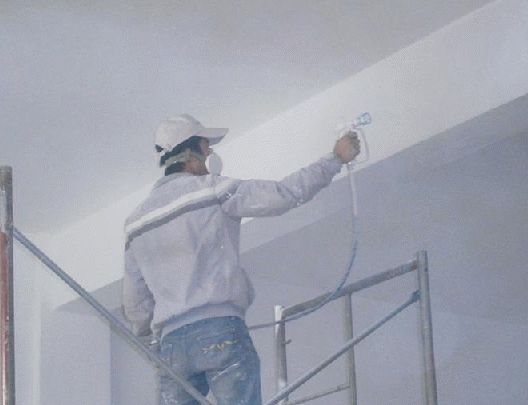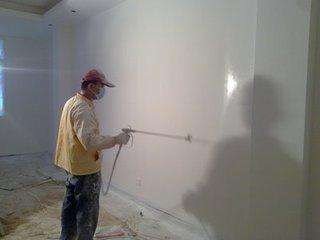Wall paint still occupies a huge market, which makes its derivative industry flourish. For example, when it comes to paint on the wall, in fact, the paint on the wall is also divided into two methods, painting and painting, then the two paints What are the advantages and disadvantages and differences in construction? What are the techniques for waterborne coating construction operations? let's figure it out together! â—† The advantages and disadvantages of spray paint and paint: Spray paint: A method of dispersing a uniform and fine mist through the spray gun with air pressure and applying it to the surface of the object. (Can be divided into various types of air spray paint, airless spray paint and electrostatic spray paint method). However, the machines for painting are more expensive and generally not used by painters. The advantages of painting are: quick construction, good flatness, and poor texture. Disadvantages of paint are: paint loss, late maintenance trouble, because the late maintenance, the workers can no longer pull the painting machine over maintenance, can only use the brush, brush out with the texture of the spray is certainly different. Brushing: Construction is relatively slow. However, the paint has a rolling texture and pattern and is easy to maintain. The disadvantage of brushing paint is that the effect of the big-faced roller coating is different from that of the inside corner and the inside of the lamp slot, and there is a difference in texture. At present, many paint companies have promised to spray paintings for the owners free of charge, but they are basically not responsible for grassroots processing, and the primary treatment of latex paint is the most important because the grassroots problems directly reduce the final decorative effect of latex paint. In addition to the relatively large loss of paint, it is not particularly affordable. â—† Seven Tips for Waterborne Coating Construction Operations (Spraying) The spraying method is one of the most important methods for the construction of water-based paints. A thin and uniform coating film can be obtained by coating the surface of the object with a spray method. For geometrical shapes, there are small holes, gaps, unevenness, and the coating can be distributed. Uniform; For spraying large surfaces, brushing is faster and more effective. However, with the spraying method, it is also necessary to master some operating techniques: 1. Use a clean water to adjust the viscosity of the coating to a suitable spray viscosity. Measured with a Tu-4 viscometer. The appropriate viscosity is generally 20 to 30 seconds. If there is no viscometer, you can use the visual inspection method: stir the paint with a rod (iron rod or wood rod) and stir it up to a height of 20 cm to stop it. If the paint is not in a short time (several seconds) Too thick; such as a break from the bucket on the edge of the line is too thin; to just stop at 20 cm high, the paint into a straight line, the instantaneous drop off into a drop, the viscosity is more appropriate. 2, the air pressure is best controlled at 0.3-0.4 MPa (3-4 kg force / square centimeter). If the pressure is too low, the atomization of the lacquer solution will be poor, and the surface will form pits; if the pressure is too large, the dripping will be easy, and the paint mist will be too large, which will waste the material and affect the operator's health. 3, the distance between the nozzle and the object surface is generally 300-400 mm. Nearly easy to hang; over uneven paint spray, prone to pitting, and the nozzle away from the object paint mist sprayed on the way to cause waste. The specific size of the distance should be appropriately adjusted according to the type, viscosity, and pressure of the paint. Slow-drying paint spraying distance can be farther, quick-drying paint spraying, the distance can be a little closer; thick viscosity can be near a little, when the viscosity is thin, it can be farther; when the air pressure is big, the distance can be farther, the pressure can be a little nearer; Closer to the farther point is the adjustment of a small range between 10 mm and 50 mm. Above this range, it is difficult to obtain a desired film. 4, the order of spraying is: first, after the first, after the outside. After the first height and then the low, the first small area after a large area. This will not cause the post-spray paint mist to splash on the sprayed paint film, destroying the sprayed paint film. 5, the spray gun can be used to move up and down, left and right, it is best to run evenly at a speed of 10-12 meters / minute, the nozzle should be straight to the surface spray, to reduce the oblique spraying. When spraying on the both ends of the object, the hand that deducts the trigger of the spray gun should be loosened quickly, so that the paint mist is reduced. Because the two ends of the object surface are often subjected to more than two times of spraying, it is the place most likely to cause sagging. 6, when the next spray to suppress a 1/3 or 1/4, so that there will be no leakage phenomenon. When spraying quick-drying paint, it should be sprayed in order. Spraying effect is not ideal. 7, when spraying in outdoor open places, pay attention to the wind direction (difficult to work when the wind), the operator must stand in the downwind direction, to prevent the paint mist from being blown into the paint film has caused an unsightly granular surface. â—†Precautions for spray painting operation 1, for the same side of the wall, it is best to choose the same batch and color spray paint, this will not cause color, the effect will be better. 2. Before spray painting, be sure to test spray first to see the effect of color so that spray paint can achieve the desired effect. 3. After the painting is completed, if the paint in the can is not used, it must be inverted. This can prevent the gas in the can from blocking the can, and then it will not make the can be scrapped. The above is the knowledge of the seven techniques for the construction of waterborne paints. Wall painting is not easy to do. We need to pay attention to many small details when we operate. There are also various skills to be mastered during construction. Well, let's have a special master to operate. If you have any other questions, please leave a message and we will answer your questions as soon as possible! For more information, please follow this site! Construction Acceptance Renovation Experience Three Trees Lacquer Paint Lacquer Decoration Company Decoration Welded WIRE MESH fence is a type of fencing made from steel wires arranged in a grid or mesh pattern. This type of fence is known for its strength and durability, making it an ideal choice for high-security areas. The wires are welded at each intersection to increase the fence's strength and resistance. Welded Wire Mesh Fence,Welded Wire Fence,Pvc Coated Wire Mesh,Welded Mesh Fencing Hebei Aibuer trading co., Ltd , https://www.ablehardwares.com


A welded wire fence, on the other hand, is a more general term that can refer to any fence made from welded wire, regardless of the specific pattern or design. This can include everything from simple garden fences to heavy-duty security fences.
PVC coated wire mesh is a type of welded wire fence that has been coated with a layer of polyvinyl chloride (PVC) for added durability and resistance to the elements. This coating can also give the fence a more attractive, finished look and can be available in a variety of colors.
Welded mesh fencing is a versatile and popular choice for both residential and commercial fencing applications. It is typically used for security, to keep out unwanted visitors, or to contain pets or livestock. The strength and durability of welded mesh make it a reliable choice for these applications, and its relatively low cost and easy installation make it a practical choice as well.